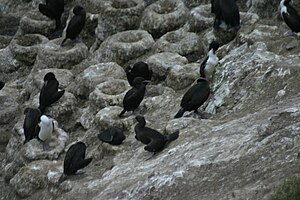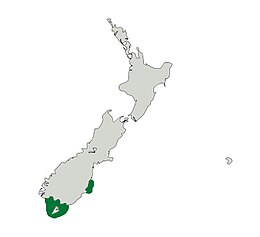Otagosharbe
| Otagosharbe | ||||||||||||
|---|---|---|---|---|---|---|---|---|---|---|---|---|

Otagos sharks ( Leucocarbo chalconotus ) in a breeding colony |
||||||||||||
| Systematics | ||||||||||||
|
||||||||||||
| Scientific name | ||||||||||||
| Leucocarbo chalconotus | ||||||||||||
| ( GR Gray , 1845) |
The Otagoscharbe ( Leucocarbo chalconotus , Syn . : Phalacrocorax chalconotus ) is a species of bird from the genus Leucocarbo within the cormorant family . The species inhabits a small area on the coast of New Zealand's South Island . It breeds in colonies and feeds primarily on fish . The IUCN lists the species as endangered ("vulnerable") because of the small and declining total population. The population is estimated at 5,000 to 8,000 sexually mature individuals. As with many cormorants, the species status is controversial.
Appearance
Otagos shards reach a head-trunk length of 65 to 71 centimeters and a weight between 1797 and 3875 grams. The species shows a sexual dimorphism , the males are slightly larger and heavier than the females. It is very similar to the slightly larger warthog , but occurs in two color morphs . The plumage of the more common Morph is dark brown, with an orange-colored beak base and an equally colored throat skin. The light morph shows a little more white on the wings and chest than the wart shag as well as a red beak base and throat skin. The gray beak of the otago shark is slightly shorter and narrower than that of the warthog. The iris is dark blue in color. The legs and feet of both morphs are flesh-colored. Both morphs can occur in a breeding colony. Young birds are already very similar to the adult birds, but have brown instead of black feathers.
On land, Otagos sharks can move very well, typical for them when running is a very upright posture and very strong lifting of the feet. The flight is reminiscent of fruit bats, on longer flights the head is carried below the body axis. In the breeding colonies, barking noises can be heard from the males, whereas the females seldom utter vocalizations.
Within the distribution area there are several species of cormorant with which the Otagoscharbe can be confused. The light colored morph shows a resemblance to the magpie , the dark morph can be confused with the common cormorant . However, both species have black feet and legs and longer wings in proportion to their height. They also differ in their behavior from that of the Otagoscharbe. Unlike these, they spread their wings after the dives to dry them. The similar looking warthog only occurs on the northern tip of New Zealand's South Island and is accordingly absent in the distribution area of the Otagoshark. The same applies to the Chatham shear , which is only found in the region of the Chatham Islands .
distribution and habitat
Otago sharks live in the region of Otago . There they mainly populate shallow coastal waters and rarely move more than a few kilometers from the coast.
The Otagoscharbe is a resident bird and young birds also show no tendency to dismigrate .
food
Around 70% of the diet consists of small fish , especially perch and plaice . A smaller proportion of the diet consists of crabs and other invertebrates . Like all cormorants, the species prefers to hunt its prey by diving, following and catching it while swimming underwater. During the dives they reach a water depth of up to 30 meters, while foraging for food they stay up to 15 kilometers from the coastline. Foraging phases last about two hours in shallower water, with about two hours in between. They are solitary in foraging for food and only look for food during the day.
Reproduction
The way of life and the reproductive biology of the Otagoscharbe has not yet been conclusively investigated. However, they enter into a monogamous couple relationship that is believed to last more than one breeding season. Both parent birds breed and are involved in the rearing of the young birds. The species currently breeds in nine colonies of up to a few hundred breeding pairs on rocky outcrops and steep slopes, some colonies are on small rock islands. In one breeding colony it has been found that the older pairs colonize the upper ledges, while the more inexperienced pairs nest predominantly on the lower ledges. The nests, which are mainly made of small sticks, algae and grass , are solidified with excrement . Since they are used again every year and are constantly being expanded, they can reach heights of over a meter. The distance between the individual nests is very regular, the distance is just big enough that the breeding birds cannot reach each other with their beaks. "Corridors" in the breeding colonies allow the Otagos sharks to cross the breeding colony without being attacked by breeding birds.
Due to the nest-building activities, the vegetation that surrounds the breeding colonies is increasingly disappearing. It is likely that this diminishing vegetation will result in breeding colonies being abandoned after a few years and only repopulated once the vegetation has recovered.
The breeding season usually begins in spring, but varies greatly from year to year and depends on the climatic conditions and the food supply. The size of the clutch has not yet been conclusively investigated, presumably between two and three eggs are laid. These are elliptical and have a rough surface. The shell is pale blue. The chicks hatch naked, and after a few days a gray down dress will grow on them . From an age of around seven days, the nestlings beg with high-pitched cries for food, the parent birds usually return to the nest in the late afternoon and feed the young from the edge. Older nestlings that have already left the nest form small groups in the edge of the colony. Those who are still in the nest chop for adult Otagos shards if they come too close to the nest. So far, no studies are available on the breeding success.
Systematics
As with all cormorants, the exact systematic position of the species is disputed. The Otagosharbe belongs to a group of cormorant species in the southern hemisphere, which are divided into different species due to their often small morphological differences. The correctness of this approach is highly controversial. A final clarification of the system using genetic methods is still pending. The Otagos Shark is considered by some scientists to be a subspecies of the very rare warthog .
Hazard and protection
The IUCN lists the species as " endangered (vulnerable) ", as the total population is estimated at only 5000 to 8000 animals and some of the few breeding colonies have been destroyed by human influence in recent years and the number of breeding birds is falling. Illegal hunting of otago sharks is another threat. Commercial fishing is seen as a major factor influencing the otagus shark population. Otagos sharks are often caught in gillnets and then drown. In the breeding colonies on the mainland, the introduced weasels and polecats, feral domestic cats and rodents also represent a threat. Due to the small distribution area, the species can only compensate for losses very slowly.
One of the protective measures that BirdLife International proposes for this species is the protection of all breeding colonies of this species. BirdLife International also proposes fencing off the breeding colonies to prevent the entry of introduced wild animals and domestic animals into the area of the breeding colonies and to prevent commercial fishing with gill nets in the vicinity of breeding colonies. The establishment of commercial fish farms near breeding colonies and in the feeding grounds of the Otagoscharbe should also be prevented from the perspective of BirdLife International.
supporting documents
literature
- Josep del Hoyo , Andrew Elliot, Jordi Sargatal: Handbook of the birds of the world. Volume 1: Ostrich to Ducks. Lynx Edicions, Barcelona 1992, ISBN 84-87334-10-5 .
- PJ Higgins (Ed.): Handbook of Australian, New Zealand & Antarctic Birds , Volume 1, Ratites to Ducks, Oxford University Press, Oxford 1990, ISBN 0195530683
Web links
Individual evidence
- ↑ Leucocarbo chalconotus in the endangered Red List species the IUCN 2010. Posted by: BirdLife International, 2010. Accessed March 16, 2011th
- ↑ BirdLife Factsheet on the Otagoscharbe , accessed May 14, 2011
- ^ Higgins, p. 876
- ^ Higgins, p. 876
- ^ Higgins, p. 877
- ^ Higgins, p. 877
- ^ Higgins, p. 877
- ↑ BirdLife Factsheet on the Otagoscharbe , accessed May 14, 2011
- ^ Higgins, p. 879
- ↑ BirdLife Factsheet on the Otagoscharbe , accessed May 14, 2011
- ↑ BirdLife Factsheet on the Otagoscharbe , accessed May 14, 2011
